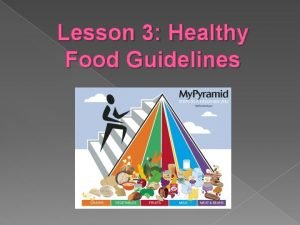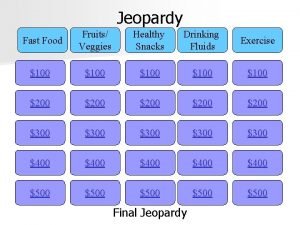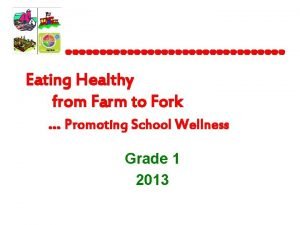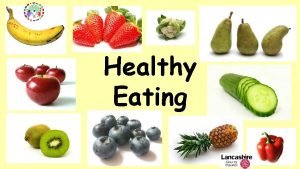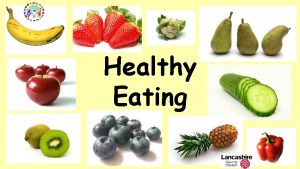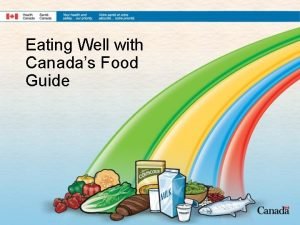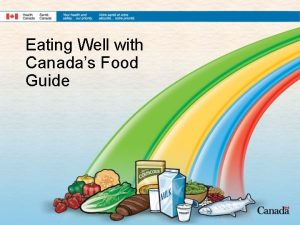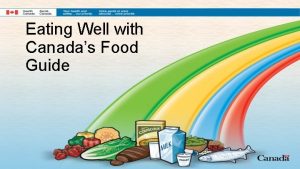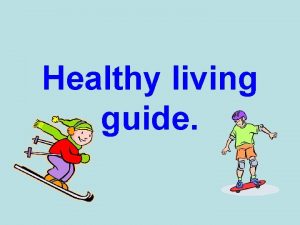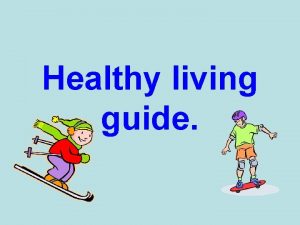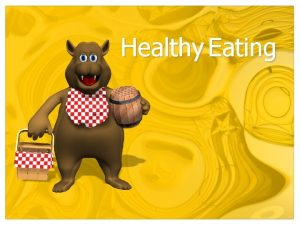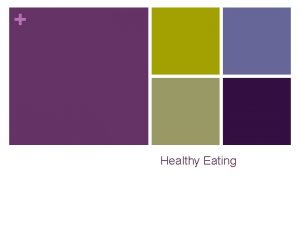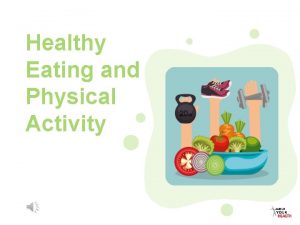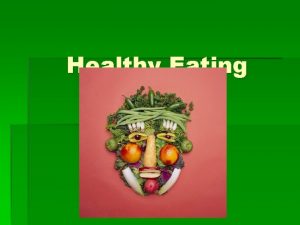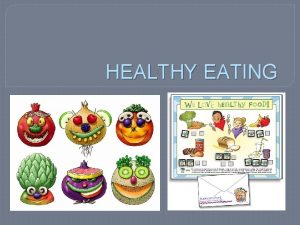Healthy Eating Living 1 Nutrition Follow Canadas Food















- Slides: 15

Healthy Eating & Living

1. Nutrition Follow Canada’s Food Guide for servings • 5 – 10 Fruits and Vegetables a day • 5 – 12 Grains and Cereals • 3 - 4 Dairy • 2 - 3 Meat and Alternatives

• Eating Well with Canada’s Food Guide





Having the Amount and Type of Food Recommended and Following the Tips in Canada’s Food Guide will help: • Meet your needs for vitamins, minerals and other nutrients • Reduce your risk of obesity, type 2 diabetes, heart disease, certain types of cancer and osteoporosis • Contribute to your overall health and vitality

Canada’s Food Guide also Recommends: – Satisfying your thirst with water – Enjoying a variety of foods from the four food groups

Canada’s Food Guide also Recommends: – Limiting foods and beverages high in calories, fat, sugar or salt – Examples include cakes and pastries, doughnuts and muffins, french fries and potato chips, nachos and other salty snacks, alcohol, fruit flavoured drinks, soft drinks, sports and energy drinks

Read the Label • Compare the Nutrition Facts table on food labels to choose products that contain less fat, saturated fat, trans fat, sugar and sodium • Keep in mind that the calories and • nutrients listed are for the amount of food found at the top of the • Nutrition Facts table

Eating Well and Being Active Work Together for a Healthier You! • The benefits of eating well and being active include: • • • Better overall health Lower risk of disease A healthy body weight Feeling and looking better More energy Stronger muscles and bones

The is what a total daily average intake should look like: 60% - Carbohydrates 20 – 30 % Fat (ONLY 10% should be Saturated Fat) 10 -20% Protein

• Carbohydrates generally provide the energy for daily activities. Carbohydrates can be simple or complex. The more complex the carbohydrate, the longer the energy will last since it takes longer to get the energy from the nutrient. • The protein builds the muscle and bones necessary to make a body grow and repair. • Fats and lipids provide a way for the body to absorb vitamins and minerals. They also provide warmth and insulation. Another benefit is that they keep the skin healthy. Fats are also a way the body stores extra energy.

Tips for Eating At a Restaurant Most restaurant portions are way larger than the average serving of food at home. Ask for half portions, share an entrée with a friend, or take half of your dish home. Here are some other restaurant survival tips: Ask for sauces and salad dressings on the side and use them sparingly. Use salsa and mustard instead of mayonnaise or oil. Ask for olive or canola oil instead of butter, margarine, or shortening. Use nonfat or lowfat milk instead of whole milk or cream. Order baked, broiled, or grilled (not fried) lean meats including turkey, chicken, seafood, or sirloin steak. § Salads and vegetables make healthier side dishes than french fries. Use a small amount of sour cream instead of butter if you order a baked potato. § Choose fresh fruit instead of sugary, high-fat desserts § § §
 Interactive guide to healthy eating and active living
Interactive guide to healthy eating and active living Healthy food healthy mind journal
Healthy food healthy mind journal Follow you wherever you may go
Follow you wherever you may go Temperatura cima teide
Temperatura cima teide Canadas landforms
Canadas landforms 90 of the canadian population lives within
90 of the canadian population lives within Whats canadas longest river
Whats canadas longest river Canadas physical regions
Canadas physical regions Who is canadas head of state
Who is canadas head of state What is canadas economic system
What is canadas economic system Electromagnetismo
Electromagnetismo Physical regions in canada
Physical regions in canada Canadas climate
Canadas climate Fast food jeopardy questions
Fast food jeopardy questions Healthy food sentences
Healthy food sentences Eating healthy from farm to fork
Eating healthy from farm to fork
